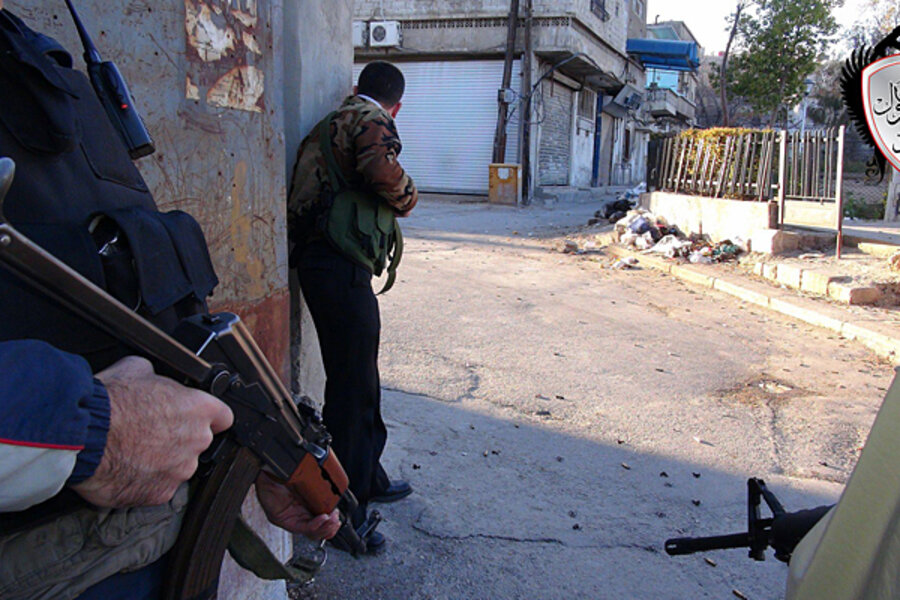Syria chemical weapons: Where did they come from?
Loading...
| Washington
Where did Syria get chemical weapons? How big is its stockpile? Those questions are more crucial than ever in the wake of reports that the US now believes President Bashar al-Assad’s Syrian regime has used the chemical agent sarin against civilians on a small scale.
After all, Syria remains one of only six countries that have not ratified the Chemical Weapons Convention, which outlaws production, storage, and use of poison gas. In 2012, Syrian officials acknowledged that they possessed such weapons and threatened to use them in the event of “foreign intervention” in Syria's ongoing conflict with domestic opposition forces.
Overall, Syria is believed to have “hundreds of tons of mustard gas, blister agents, and nerve agents, which could include sarin and the agent VX,” concludes an Arms Control Association summary of Syria’s unconventional weaponry.
The roots of Syria’s chemical weapons program lie decades in the past. Over the years, US intelligence experts have gone back and forth as to exactly when the effort began, but it is likely Syria began the effort decades ago, and possibly as early as the 1970s.
“Damascus probably developed its chemical weapons program in response to a perceived threat from Israel,” concludes a 2012 Congressional Research Service (CRS) analysis of the subject, citing US intelligence reports.
Some analysts believe that Egypt provided Syria with chemical weapons on the eve of the October 1973 Yom Kippur war. There are reports that Israeli troops captured stockpiles of gas munitions during the conflict but Syria apparently decided not to use them in spite of its eventual defeat.
In 1979, Egypt’s peace treaty with Israel fractured already-weak Arab unity in the region. Syrian-Turkish relations deteriorated due to conflicts over water rights, among other things. Syria’s then-patron the USSR decided to support theocratic Iran, secular Syria’s adversary, in the Iran-Iraq War.
“The combination of increasing political isolation and observed military deficiencies vis-à-vis Israel together provided incentives for Syria to develop a self-sufficient CW capability,” concludes a Syrian country report from the nonprofit Nuclear Threat Initiative.
As to the technology of Syria’s chemical weaponry, it’s likely the Soviet Union added more advanced equipment to the small Egyptian stockpile during the late 1970s and 1980s. Declassified US documents hold that the USSR provided Damascus with training, delivery systems, and chemical agents themselves, according to CRS nonproliferation experts Mary Beth Nikitin, Andrew Feickert, and Paul Kerr.
In 1983, a US estimate stated that Syria could not make chemical weapons on its own. By the middle and late years of the decade, US intelligence had concluded that Damascus was seeking an indigenous production capability for chemical weaponry. It remains unclear whether Syria ever reached that goal.
Today most experts agree Syria has large stocks of this weaponry. In 2012, an Israeli Defense Forces deputy chief of staff went so far as to charge that Syria had the largest remaining stockpile of chemical weapons in the world.
According to the CRS, open reports hold that Syria has mustard blister agent, a poison used in World War I, as well as more modern nerve agents such as sarin and VX.
Syria’s chemical agent facilities may be scattered throughout the country. Reportedly, there are important chemical-weapons sites at Al Safira, which is outside Aleppo; Damascus; Hamah; Latakia; and Homs.
“Stockpiles also may be dispersed in other military locations around the country, and some reports suggested that the Syrian government may have moved or consolidated chemical weapons-related materials in order to better guarantee their safety,” write CRS analysts Jeremy Sharp and Christopher Blanchard in a 2013 report on Syria’s current conflict.
Syria has Scud-class and SS-21 missiles capable of carrying chemical weapons warheads. It’s likely that Damascus also has chemical-capable artillery shells and air-dropped bombs.
Chemical weapons stockpiles can be difficult to move and handle, particularly if they are not more modern binary poisons, which consist of two substances that do not become lethal until mixed. US officials are concerned both about the use of this weaponry against Syria’s rebels and civilian population and about its eventual disposition should Mr. Assad be overthrown.
“In the wake of any sudden regime collapse, efforts to find and secure stockpiles would be both a high priority and a difficult challenge,” conclude CRS’s Mr. Sharp and Mr. Blanchard.








